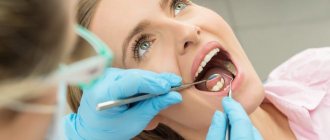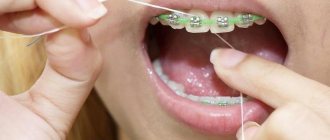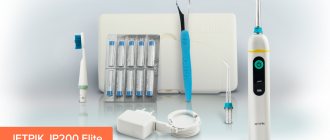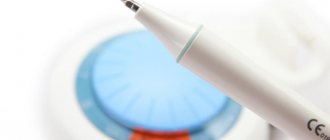What is professional teeth cleaning at the dentist?
Oral care can be done both at home and in the dentist's office. Daily home care does not completely eliminate the risk of oral diseases. Therefore, during regular dental examinations, you should periodically have your teeth professionally cleaned.
Modern cleaning methods allow you to remove all plaque from the enamel and remove existing tartar in a short time. At the same time, the teeth are restored to their natural whiteness and various oral diseases are prevented.
The professional teeth cleaning procedure is painless. Its main advantage, in addition to the removal of visible dental plaque, is the reduction of pathogenic microflora in the oral cavity and the increase of local immunity.
What is plaque and tartar?
Dental plaque is essentially a mass of food debris, saliva, pathogenic microorganisms and their waste products. Daily brushing removes plaque only on open and easily accessible areas of the teeth. In places that are difficult to clean independently, plaque accumulates in large quantities. This is, first of all, the cervical area of the teeth, fissures on the chewing surface and the gingival groove.
After a few days, the plaque turns into a hard plaque. The concentration of harmful microorganisms in it is 50% higher than in unhardened plaque. Such a plaque cannot be washed off with saliva or water. The plaque gradually grows and a very dense deposit is formed from it - tartar. This education contributes to the development of periodontal diseases (periodontitis and periodontal disease) and caries.
Myth #1: Plaque protects tooth enamel.
The myth says that natural plaque is the best protective layer that prevents the enamel from deteriorating. In fact, it is a large accumulation of bacteria on the surface of the teeth. If plaque is not removed at home and professional hygiene is neglected, it can turn into tartar.
Dentist's opinion: under the influence of saliva minerals, plaque thickens and turns into an even greater concentration of harmful bacteria that live and multiply. Intoxication of the body and inflammation in the gums occurs. The gums recede and the roots are exposed, causing sensitivity and mobility of the teeth.
What are the indications for professional teeth cleaning at the dentist?
It is recommended to consult a dentist for such a procedure in the following cases:
- The need to eliminate tartar in both supragingival and subgingival locations;
- Removing hard and soft plaque;
- For the prevention of diseases of hard dental tissues (caries and non-carious lesions);
- Treatment and prevention of periodontal diseases (gingivitis, periodontitis, periodontal disease);
- Elimination of bad breath;
- Prevention of the development of periodontal bleeding;
- As the first stage of the teeth enamel whitening procedure.
The frequency of the procedure is recommended once every 6 months, but more often is possible. Modern methods of professional teeth cleaning are very gentle and do not have a negative effect on the oral cavity or to a minimal extent.
You can independently determine when you need to visit a clinic for professional cleaning by looking at the following negative signs in the oral cavity:
- Bad breath, but gastrointestinal diseases have not been diagnosed;
- There is bleeding gums, itching and burning in the mouth;
- Visual presence of tartar;
- The tooth may hurt;
- Change in periodontal color (cyanosis or hyperemia);
- There is subsidence of the gums, they may bleed;
- There is a feeling of heaviness and pain in the periodontium when chewing food, especially sour or spicy;
- There is a violation of the periodontal attachment.
It should be noted that there are practically no contraindications for professional teeth cleaning. There are only general relative limitations, such as the acute stage of inflammatory processes in the body.
The basic methods of professional teeth cleaning are based on a modern correct approach to the problem and involve a complex effect during the process of professional teeth cleaning at the dentist. At the same time, manual and hardware cleaning methods are distinguished.
Hardware methods of teeth cleaning
Professional oral cleaning is performed by periodontists or hygienists. The procedure is preventive and does not require special preparation; in extreme cases, local anesthesia is performed. Of the hardware methods, the following techniques are the most popular.
Cleaning teeth at the dentist using the air flow method
During the cleaning process using the Air Flow method, hard dental deposits are exposed to abrasive material and a powerful stream of directed air. The abrasive commonly used is sodium bicarbonate. Cleaning takes place simultaneously with the supply of a thin stream of water. For an additional refreshing effect, different flavors (mint, lemon or menthol) are added to the water.
Cleaning occurs due to soda particles, which hit the enamel at high speed, removing both soft and hard plaque. At the same time, the supplied stream of water washes away the removed deposits and stones so that they do not interfere with further exposure. Water also helps reduce the heating of tooth enamel that occurs during this manipulation.
The Air Flow technique helps not only to eliminate plaque, stones and pigmentation, but also to thoroughly polish the enamel, at the same time ensuring its partial lightening. However, it should be remembered that air flow cannot whiten tooth enamel by several tones. After manipulation, hard tissues will only acquire their original color.
Reviews about Air Flow are in most cases positive, since the main advantages of the technique include:
- Availability;
- Safety;
- Painless;
- High efficiency.
The entire effect takes no more than 30 minutes. Moreover, the air flow is selected individually for each patient. And the power directly depends on the volume of dental plaque that needs to be removed. In addition, the thickness of the enamel and the individual sensitivity of the teeth are taken into account.
Despite the positive aspects of professional teeth cleaning using the Air Flow method, there are quite significant contraindications to this method. First of all, these are diseases of the respiratory tract. These include:
- Obstructive bronchitis;
- Bronchial asthma;
- Allergy to airflow components;
- Acute periodontal and hard tissue diseases;
- Multiple caries;
- Thin layer of enamel;
- Non-carious lesions associated with increased sensitivity of enamel and its excessive fragility.
The cost of the procedure in dental offices is usually not high and is affordable for everyone. In just 3-4 thousand rubles you can get a good preventive effect using the Air Flow method, as well as additional services to strengthen the hard tissues of teeth. The effect after the procedure lasts depending on the patient’s lifestyle and the absence or presence of somatic diseases. In any case, it is advisable to visit the dentist again no later than six months later.
Possible contraindications
Despite the safety of hygienic cleaning, this procedure is contraindicated for some patients. It is not recommended if you have:
- arrhythmias;
- increased sensitivity or erosion of enamel;
- gingivitis;
- acute respiratory diseases.
Dental hygienic treatment is prohibited for pregnant women and adolescents who have not changed their primary dentition to a permanent one. If there are contraindications, the doctor can carry out the procedure manually or using special pastes and attachments for a drill. This will allow you to simultaneously remove deposits and polish the enamel.
Ultrasound teeth cleaning method
The effect of ultrasound on tartar greatly facilitates the process of their removal. The procedure is faster and less tiring for the patient; it can be used to remove both subgingival and supragingival deposits. An important advantage of ultrasound is its antibacterial and antimicrobial effect on almost all microorganisms in the oral cavity.
The ultrasound waves used for cleaning are completely safe for the oral cavity. In addition, there are various attachments for the emitter that allow you to most effectively remove plaque and tartar even in the most difficult areas of the jaw. In this case, the tartar not only flakes off, but is also partially destroyed. What is important when removing it from periodontal pockets, since instrumental treatment of these places will be quite traumatic and painful for the patient. The gentle impact of ultrasound allows for a gentle effect on tooth root cement and enamel.
In parallel with ultrasonic vibrations, a stream of liquid is supplied to the oral cavity, washing away all remnants of stones and plaque from the interdental spaces and gum pockets.
Usually, just one session of professional teeth cleaning with an ultrasonic dentist is enough to remove all hard and soft deposits. In addition, this also causes partial lightening of hard tissues.
This cleaning method has practically no disadvantages, however, there are contraindications to ultrasonic teeth cleaning:
- A pacemaker installed in the patient;
- The presence of renal, pulmonary and liver failure;
- The presence of cardiovascular diseases in a severe stage;
- Extensive demineralization of enamel;
- Purulent diseases of periodontal and oral mucosa;
- Installed orthopedic structures, especially those made using metals;
- Multiple caries and its various complications with the formation of purulent exudate.
Ultrasonic teeth cleaning is very accessible in dentistry, which is explained by the following points:
- There are many companies offering devices for this method in dentistry;
- The cost of services using ultrasound is not very high. Many dentists offer professional teeth cleaning with ultrasound at a price from 1200 to 4000 rubles, the cost varies depending on the amount of work.
The effect of the ultrasonic cleaning procedure lasts for at least 1 year, provided the patient follows the recommendations for careful home dental care.
Myth No. 2: electric brushes and professional hygiene spoil the enamel
Many are sure that electric brushes are evil that wear away enamel. But, according to experts, high-quality electric brushes provide equal pressure on the teeth, unlike regular ones. Ultrasonic cleaning, if the technique is followed, also does not damage the enamel. It is important to take the choice of a specialist seriously.
Dentist's opinion: professional oral hygiene correctly performed by a dentist cannot be harmful, but, on the contrary, is considered a mandatory therapeutic and preventive procedure to maintain healthy teeth and gums.
Laser therapy method for teeth cleaning
The laser therapy technique is the most modern today. Its effect is based on the evaporation of liquid. The fact is that there is much more of it in plaque and tartar than in enamel. The laser, evaporating liquid from deposits, allows you to destroy the stones layer by layer.
Hygienic cleaning of teeth with a laser is carried out at a distance, without contact of instruments with oral tissues. Thus, this technique is completely painless. When it is carried out, there is no chance of infection, and the laser itself has an antiseptic effect.
Another advantage of laser cleaning at the dentist is that it helps to further whiten the enamel. Thanks to this, there is no need for another procedure. In addition, the light flux has a bactericidal effect and effectively fights pathogenic microorganisms, helps in the regeneration of wounds and prevents the development of caries. The entire procedure does not require any special preparations and is painless for the patient.
Laser teeth cleaning is contraindicated under the following conditions:
- Rhinitis and ARVI;
- The presence of implants, including pacemakers, in the patient’s body;
- Severe infectious diseases (HIV infection, tuberculosis, hepatitis);
- The presence of orthopedic structures in the oral cavity;
- The patient has a history of epilepsy and asthmatic attacks.
Why do you need to brush your teeth?
Why do you need to brush your teeth several times every day?
The oral cavity is an ideal place for the rapid reproduction and activity of pathogenic bacteria. Here, optimal conditions are created for various types of microorganisms:
- Temperature close to 37 °C.
- High humidity.
- Availability of a food source (leftover food).
- Lack of sunlight, which is a source of ultraviolet radiation that kills harmful bacteria.
This is why microbes multiply quickly in the cavity and mouth and feel very comfortable there. Among the representatives of microflora there are both beneficial microorganisms and pathogenic ones, which, as a result of active division, can provoke the development of various serious diseases, such as stomatitis and caries. Since thorough brushing of teeth eliminates a significant part of these microorganisms, their negative effects are minimized. For this reason, you need to brush your teeth regularly and do it correctly.
Manual professional teeth cleaning
With an integrated approach to teeth cleaning, the manual method is used last by dentists. With it you can:
- Smooth out roughness caused by plaque;
- Eliminate plaque and tartar residues in difficult-to-treat areas of the oral cavity;
- Remove surface pigmentation from food dyes on enamel;
- Treat interdental spaces;
- Stop the development of pathology in the periodontium.
Manual teeth cleaning is the final stage of the entire procedure and is carried out using various instruments. The most popular are strips - special strips with a rough coating. Using strips, the dentist eliminates all errors caused by hardware in the interdental spaces. Floss or dental floss is used in the same way.
Brushes with polishing pastes are quite popular, effectively removing even very old plaque and stones. For a more powerful impact, instruments such as curettes are used. They are produced to work in a wide variety of groups of teeth. They have a very sharp working surface, so if used correctly they can remove all deposits as effectively as possible.
Myth No. 5: After cleaning, plaque forms even faster
There is an opinion that after brushing, plaque appears on the teeth even faster and becomes even more noticeable. This can actually happen if you turn to a non-professional. During the procedure, an Air-flow device is used, which uses sand pressure to remove dark plaque in hard-to-reach places. The enamel becomes slightly uneven, the new coating fits perfectly on it.
Dentist's opinion: in order to avoid this undesirable effect, competent doctors always polish the surface of the teeth with brushes and professional toothpaste after Air-flow. After this treatment, the teeth become perfectly smooth and clean again.
Oral care after professional teeth cleaning
During the first 24 hours after professional teeth cleaning, patients are not recommended to eat foods with pronounced coloring components. It is advisable to give up strong coffee, tea and smoking. Also, during the appointment, the dentist must apply special products to prevent the formation of deposits and strengthen the enamel.
After eating, you need to brush your teeth or at least rinse your mouth with water, eat an apple or chew gum. Today there are a large number of toothpastes that actively prevent the formation of any deposits. It is advisable to have them recommended to you by your dentist.
All this will help not only avoid the formation of tartar, but also prevent many diseases of the periodontium and hard dental tissues.
How often should I clean?
Dentists have a unanimous opinion on the issue of frequency of teeth cleaning. The procedure should be performed 1-2 times a year, but not more often, so as not to damage the enamel.
It is necessary to take into account the individual characteristics of the body - for some it is enough to clean the stone once a year, while for another person plaque formation occurs faster, and he needs to visit the dental clinic once every six months.
In addition, professional teeth cleaning is indicated before prosthetics, implantation and dental treatment, as well as before teeth whitening. A clean tooth surface will allow the dentist to do his job better:
- better choose the color of the filling, crown or veneer;
- notice the onset of caries in time;
- prevent many gum diseases;
- achieve good treatment and whitening results.
This manipulation is recommended for those people who smoke and often drink drinks with dyes (tea, coffee, wine, etc.).
At what age should a child brush his teeth?
This question concerns all young fathers and mothers. What do experts say about this? Should children have their teeth brushed? Dentists offer two options:
- Children should begin oral hygiene procedures even before the first tooth erupts. Microorganisms accumulate both on the surface of the enamel and on the mucous membrane of the cheeks, gums, palate, and tongue. Therefore, young children, like adults, need hygiene. Cleaning the oral cavity should begin at 3-4 months of age. For this purpose, a special children's silicone brush is used, which is placed on the finger.
- Children need to brush their teeth after teething. This process is individual for each child, so it is difficult to give exact dates. There is no need to try to brush the tooth at the moment of its eruption; you need to wait until it is completely finished so that the child does not get hurt. After this, you can purchase a children's brush, which has bristles made of silicone and has a special stop. You need to start brushing your teeth without toothpaste.
Since there is no clear answer to the question posed, each situation must be approached individually. To begin, parents should consult with their pediatrician and pediatric dentist. Specialists will help you choose the optimal time to start oral hygiene procedures.










